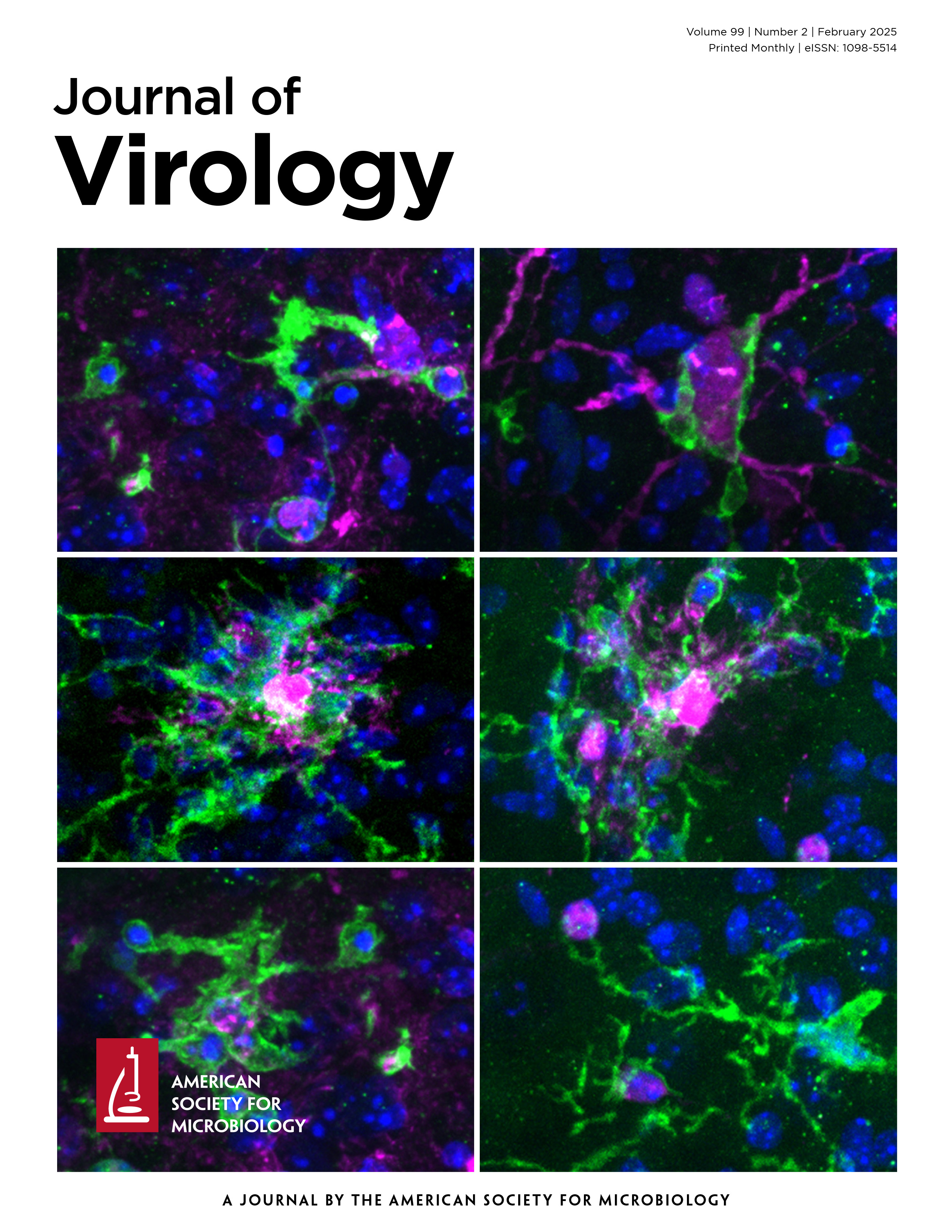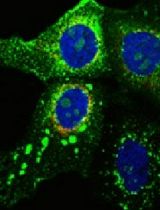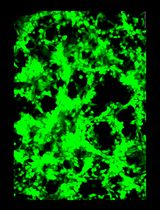- EN - English
- CN - 中文
Assembly and Mutagenesis of Human Coronavirus OC43 Genomes in Yeast via Transformation-Associated Recombination
基于转化相关重组的酵母体系组装与诱变人冠状病毒OC43基因组
发布: 2025年08月20日第15卷第16期 DOI: 10.21769/BioProtoc.5422 浏览次数: 2605
评审: Alba BlesaAnonymous reviewer(s)

相关实验方案
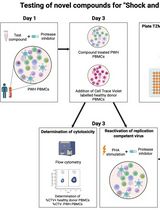
诱导型HIV-1库削减检测(HIVRRA):用于评估外周血单个核细胞中HIV-1潜伏库清除策略毒性与效力的快速敏感方法
Jade Jansen [...] Neeltje A. Kootstra
2025年07月20日 2270 阅读
Abstract
Human coronavirus OC43 (HCoV-OC43) is an endemic “common cold” coronavirus widely used to study fundamental aspects of coronavirus biology and to test therapeutic interventions. Recently, we used a yeast-based reverse genetics strategy to create recombinant HCoV-OC43 and fluorescent reporter viruses. We assembled a DNA copy of the HCoV-OC43 genome from six linear dsDNA fragments and a linearized yeast centromeric plasmid/bacterial artificial chromosome (YCpBAC) vector in Saccharomyces cerevisiae using transformation-associated recombination (TAR). Reporter genes encoding mCardinal fluorescent protein or histone H2B fused to mClover3 (mClover-H2B) or mRuby3 (mRuby-H2B) were inserted into an intergenic region between the HCoV-OC43 M and N genes. Assembled full-length HCoV-OC43-encoding plasmids were delivered into permissive mammalian cells to initiate viral gene expression, genome replication, and production of infectious progeny. This technique allows for the precise mutagenesis of any area of the HCoV-OC43 genome using homologous recombination, yielding genetically defined reference plasmids for the future generation of HCoV-OC43 virus stocks.
Key features
• Utilizes the previously developed TAR assembly method [1] to assemble and mutagenize a double-stranded DNA copy of the single-stranded RNA HCoV-OC43 genome [2].
• The availability of multiple sub-genomic and full-length HCoV-OC43-encoding plasmids provides flexibility in how substitution or deletion mutations can be incorporated using PCR or restriction cloning.
• Reporter viruses enable rapid visualization and quantification of infection.
• Generate and isolate a mutagenized HCoV-OC43 plasmid in approximately 14 days, followed by rescue of infectious virus in an additional 12–16 days.
Keywords: Virus (病毒)Graphical overview
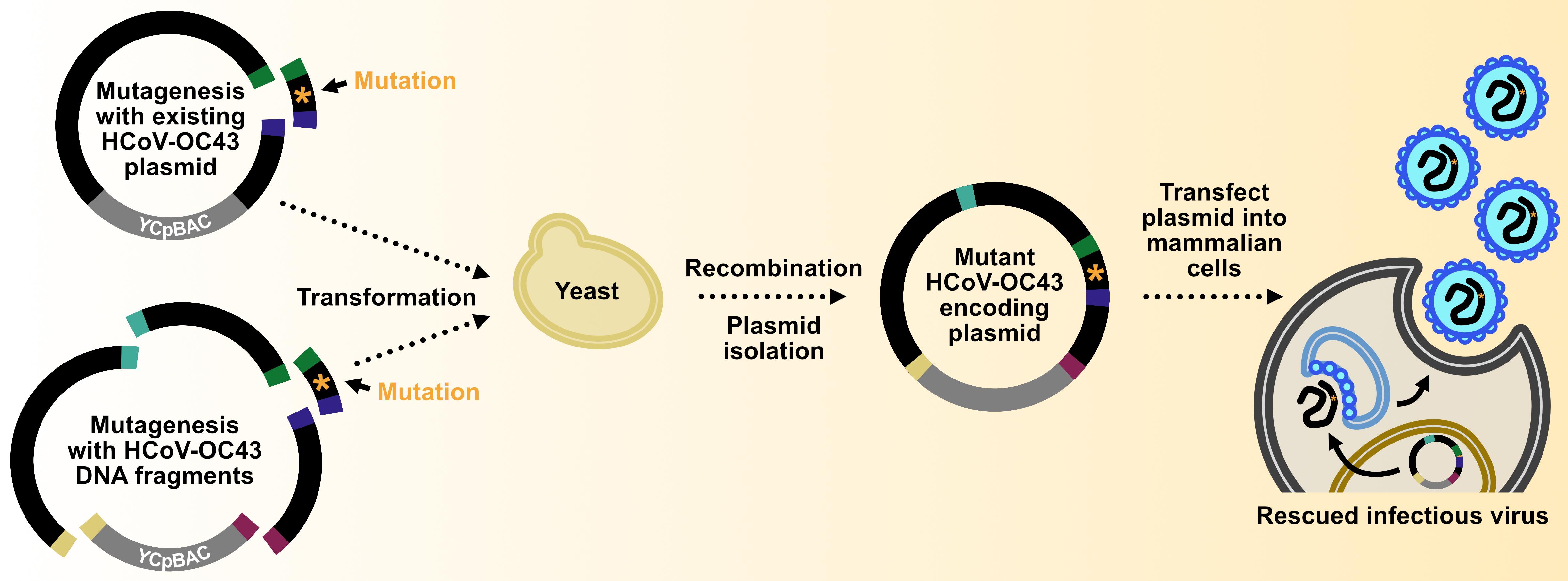
Background
Viral reverse genetics systems are essential tools for manipulating viral genomes to elucidate fundamental aspects of virus biology, developing reporter viruses to track or measure viral replication, and evaluating antiviral interventions. A common tactic for manipulating large, positive-sense, single-stranded RNA (ssRNA) coronavirus genomes involves encoding genetic information as complementary DNA (cDNA) copies that are more easily manipulated and propagated in vitro. Multiple techniques have been used to generate intact, full-length DNA copies of coronavirus genomes, including Vaccinia virus vectors [3–6], bacterial artificial chromosomes (BACs) [7–15], and, most recently, yeast episomal or centromeric plasmids [2,16–21].
Using Saccharomyces cerevisiae, large DNA plasmids encoding entire viral genomes are assembled from smaller double-stranded (dsDNA) fragments via homologous recombination using a technique known as transformation-associated recombination (TAR). This allows for larger viral genomes to be broken down into more manageable fragments amenable to DNA synthesis or standard mutagenesis techniques. Provided that adjacent dsDNA fragments share ~50 bp of homologous sequence, fragments will be stitched together using the efficient DNA recombination machinery in S. cerevisiae. Yeast assembly of viral genomes began with the cloning of the 5.4 kb bacteriophage øX174 genome [22]. Since then, this technique has been successfully applied to multiple RNA and DNA viruses, with the largest viral assembly (235 kbp) completed for the human cytomegalovirus genome [23].
We used this yeast TAR approach to establish a system for assembly and mutagenesis of the human coronavirus OC43 (HCoV-OC43) genome, resulting in the generation of four independent full-length infectious clones of HCoV-OC43 in yeast centromeric plasmid/bacterial artificial chromosome vectors (HCoV-OC43-YCpBACs) [2]. This provides starting materials for others interested in rapid coronavirus genome assembly and mutagenesis to support research using HCoV-OC43. Our protocol describes the process of generating HCoV-OC43 mutant viruses from initial design to virus rescue (Figure 1) and is applicable to make mutant viruses in the wild-type or reporter virus backgrounds. These plasmids contain the required regulatory features to support the recovery of infectious viruses in mammalian cells (Figure 2). We provide an example of a two-fragment assembly to insert an mRuby3-H2B reporter gene into CMVn-OC43-WT-Ribo-BGH-YCpBAC (Figure 3); however, the same process applies for assemblies with more fragments using any of our HCoV-OC43-YCpBAC plasmids.
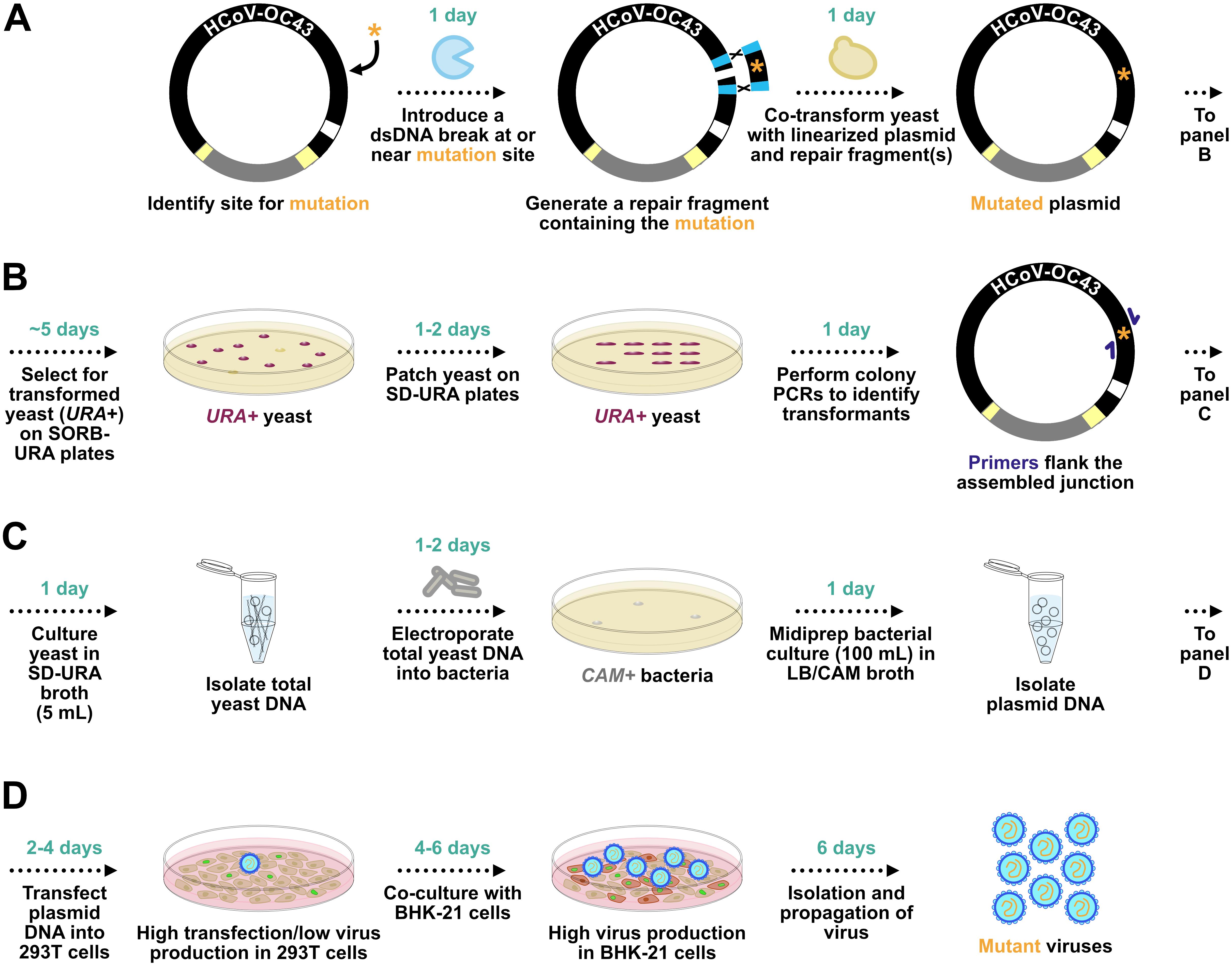
Figure 1. General overview of HCoV-OC43-YCpBAC mutagenesis, plasmid selection and propagation, and virus rescue. (A) Following the identification of a site (orange asterisk) for mutagenesis in silico, a DNA endonuclease is used to introduce a dsDNA break at or near the site for mutagenesis. A dsDNA homology-directed repair (HDR) fragment is designed carrying the mutagenized sequence with flanking homology regions (light blue rectangles) to sequences flanking the mutagenesis site in the HCoV-OC43-YCpBAC. The linearized HCoV-OC43-YCpBAC and the HDR fragment are co-transformed into yeast to create the mutated plasmid. (B) The yeast carrying the re-circularized HCoV-OC43-YCpBAC (maroon colonies) are selected on plates lacking uracil due to the orotidine 5-phosphate decarboxylase (URA) gene present in the YCpBAC. Yeast are patched onto SD-URA plates, and then colony PCRs are performed using primers (dark blue arrows) flanking the HDR fragment/YCpBAC junctions to identify correct transformants. (C) Yeast with the correctly mutated HCoV-OC43-YCpBAC are grown in liquid cultures lacking uracil, from which total yeast DNA is isolated and used to transform Escherichia coli with plasmid selection via chloramphenicol acetyltransferase (CAM) expression from the YCpBAC. (D) The mutated HCoV-OC43-YCpBAC is then transfected into 293T cells, followed by a co-culture with BHK-21 cells, to rescue mutant viruses.

Figure 2. Transcription/RNA regulatory features of HCoV-OC43-YCpBAC plasmids to facilitate virus rescue in mammalian cells. The HCoV-OC43-YCpBACs described in this protocol are designed for virus rescue in mammalian cells. Upstream of the HCoV-OC43 5′ untranslated region (5′ UTR) sequence is a human cytomegalovirus promoter (CMVpro; blue highlighted region) sequence to initiate mRNA transcription. HCoV-OC43-YCpBACs reporter genes (Rep) are inserted in the intergenic region between the M and N genes under the control of the N transcription regulatory sequence (TRS, TRS for Rep sgRNA; maroon-highlighted region). The N gene in these reporter virus genomes is under the control of a duplicated version of the N TRS (TRS*; maroon-highlighted region). Immediately 3′ to the HCoV-OC43 3′ UTR sequence is an encoded poly(A) sequence followed by a hepatitis delta virus ribozyme (HDV ribozyme) sequence (teal-highlighted region) to generate mRNAs terminating in poly(A) sequences following transcription in mammalian cells. Downstream of the HDV ribozyme is a bovine growth hormone polyadenylation [BGH poly(A)] signal (teal-highlighted region) to facilitate mRNA transcription termination.

Figure 3. DNA fragments used in the generation of CMVn-OC43-mRuby-Ribo-BGH-YCpBAC. The CMVn-OC43-WT-Ribo-BGH-YCpBAC was digested with PmeI and I-SceI to generate the YCpBAC fragment for TAR mutagenesis to insert the mRuby-H2B reporter gene into the OC43 genome. The HDR fragment carrying the reporter gene was generated from SalI/SgrAI digestion of OC43TAR456-mRuby-YCpBAC. The regions of homology to direct plasmid assembly are shown with orange circles (NS2A-S) and blue circles (cos). The greyed-out sections of the plasmids did not contribute to the assembly of CMVn-OC43-mRuby-Ribo-BGH-YCpBAC. All restriction endonuclease sites are underlined.
Materials and reagents
Biological materials
1. Yeast: Saccharomyces cerevisiae VL6-48N [24], genotype: MATα, his3-Δ200, trpl-Δ1, ura3-Δ1, ade2-101, lys2, met14, cir°), storage: -80 °C in 12.5% glycerol
2. Bacteria: Stbl3 E. coli (Thermo Fisher, catalog number: C737303), storage: -80 °C in 12.5% glycerol
3. Plasmids, HCoV-OC43-YCpBAC infectious clones (GenBank ID): CMVn-OC43-WT-Ribo-BGH-YCpBAC (PQ791637), CMVn-OC43-mClover-Ribo-BGH-YCpBAC (PQ791638), CMVn-OC43-mRuby-Ribo-BGH-YCpBAC (PQ791639), or CMVn-OC43-mCardinal-Ribo-BGH-YCpBAC (PQ791640), storage: 4 °C (short term) or -20 °C (long term) [2]
4. Plasmid, OC43-N: pGBW-m4134906 expressing HCoV-OC43-N (Addgene Plasmid #151960), storage: 4 °C (short term) or -20 °C (long term)
5. Optional plasmids, HCoV-OC43 genome fragments: OC43TAR1-YCpBAC (5′ UTR-Nsp3), OC43TAR2-YCpBAC (Nsp3-Nsp11), OC43TAR3-YCpBAC (Nsp11-Nsp15), OC43TAR4-YCpBAC (NS2A-M), OC43TAR6-YCpBAC (N-3′ UTR), OC43TAR123-YCpBAC (5′ UTR-Orf1ab), OC43TAR456-WT-YCpBAC (NS2A-3′ UTR), OC43TAR456-mClover-YCpBAC (NS2A-3′ UTR), OC43TAR456-mRuby-YCpBAC (NS2A-3′ UTR), and OC43TAR456-mCardinal-YCpBAC (NS2A-3′ UTR). Storage: 4 °C (short term) or -20 °C (long term) [2]
6. Virus: Betacoronavirus 1 strain OC43 (HCoV-OC43) (ATCC, catalog number: VR-1558), storage: -80 °C
7. Cell line: Human embryonic kidney (HEK) 293T cells (ATCC, catalog number: CRL-3216), storage: -196 °C (LN2)
8. Cell line: Human embryonic kidney (HEK) 293A cells (Thermo Fisher, catalog number: R70507), storage: -196 °C (LN2)
9. Cell line: Baby hamster kidney (BHK) 21 cells (ATCC, catalog number: CCL-10), storage: -196 °C (LN2)
10. Antibodies: Mouse anti-coronavirus, OC43 strain (OC43-N; Millipore, catalog number: MAB9012); rabbit anti-OC43-S (CUSABIO, CSB-PA336163EA01HIY); rabbit anti-OC43-HE (M. Desforges); rabbit anti-β-Actin (Cell Signaling, catalog number: 8457), goat anti-mouse IgG (H+L) cross-adsorbed secondary antibody, Alexa Fluor 555 (Invitrogen, catalog number: A21422); goat anti-rabbit IgG (H+L) cross-adsorbed secondary antibody, Alexa Fluor 647 (Invitrogen, catalog number: A21244); and goat anti-rabbit IgG (H+L) cross-adsorbed secondary antibody, Alexa Fluor 488 (Invitrogen, catalog number: A11008)
Reagents
1. Yeast extract (BioShop, catalog number: YEX401)
2. Peptone (Bacteriological; BioShop, catalog number: PEP403)
3. D-Glucose, anhydrous, reagent grade (BioShop, catalog number: GLU501)
4. Adenine hemisulfate salt (Sigma-Aldrich, catalog number: A9126)
5. Agar (Sigma-Aldrich, catalog number: A1296)
6. D-Sorbitol (Sigma-Aldrich, catalog number: S1876)
7. Ethylenediaminetetraacetic acid disodium salt dihydrate (EDTA) (Wisent, catalog number: 625-060 LG)
8. Sodium hydroxide (NaOH) (EMD, catalog number: SX0590-1)
9. Sodium phosphate dibasic heptahydrate (Sigma-Aldrich, catalog number: S9390)
10. Monosodium phosphate monohydrate (EMD, catalog number: SX0710-1)
11. Tris(hydroxymethyl)aminomethane (Sigma-Aldrich, catalog number: 154563)
12. Hydrochloric acid (HCl) (Fisher, catalog number: A144-500)
13. Zymolyase, 20T (MP Biomedicals, catalog number: 0832092), storage: -20 °C to -80 °C
14. Glycerol (Sigma-Aldrich, catalog number: G5516)
15. 14.3 M β-Mercaptoethanol (Fisher, catalog number: BP176-100), storage: 4 °C
16. Sodium dodecyl sulfate (SDS) (Wisent, catalog number: 800-100 LG)
17. Calcium chloride dihydrate (CaCl2) (Sigma-Aldrich, catalog number: C3881)
18. Poly(ethylene glycol), Avg 8,000 (Sigma-Aldrich, catalog number: P5413)
19. Yeast nitrogen base, w/o amino acids, w/ ammonium sulfate (BioShop, catalog number: YNB406)
20. Yeast synthetic drop-out medium supplement, without uracil (Sigma-Aldrich, catalog number: Y1501)
21. Glacial acetic acid (Fisher, catalog number: A38-500)
22. Ficoll, type 400 (Sigma-Aldrich, catalog number: F4375)
23. Bromophenol blue (BioShop, catalog number: BRO777)
24. Tryptone (bacteriological) (BioShop, catalog number: TRP402)
25. Sodium chloride (Fisher, catalog number: BP358-10)
26. Chloramphenicol (Sigma-Aldrich, catalog number: C0378)
27. 95% ethanol (Commercial Alcohols, catalog number: P016EA95)
28. Poly-L-lysine hydrochloride (Millipore-Sigma, catalog number: P2658), storage: -20 °C
29. Trypan blue solution, 0.4% (Thermo Fisher, catalog number: 15250061)
30. PEI MAX, transfection-grade linear polyethylenimine hydrochloride, MW 40,000 (Polysciences, catalog number: 24765)
31. Oligonucleotides for TAR hooks/YCpBAC amplification and diagnostic PCR primers, storage: -20 °C
Note: Integrated DNA Technologies Ultramer DNA Oligos or PAGE purification of standard oligonucleotides is recommended for primers > 60 bp.
32. KOD Xtreme Hot Start DNA polymerase (Millipore Sigma, catalog number: 71975-M), storage: -20 °C
33. UltraPure Salmon Sperm DNA solution (Thermo Fisher, catalog number: 15632011), storage: in aliquots at -20 °C
34. Monarch PCR & DNA Cleanup kit (New England Biolabs, catalog number: T1130)
35. Monarch Spin DNA Gel Extraction kit (New England Biolabs, catalog number: T1120)
36. Taq DNA Polymerase with ThermoPol buffer (New England Biolabs, catalog number: M0267L), storage: -20 °C
37. 10 mM deoxynucleotide (dNTP) solution mix (New England Biolabs, catalog number: N0447), storage: -20 °C
38. 100 bp DNA ladder (New England Biolabs, catalog number: N3231), storage: -20 °C
39. Gentra Puregene Yeast/Bact. kit (QIAGEN, catalog number: 158567)
Note: This kit has been discontinued, but alternatives are available from other vendors (see Section H).
40. QIAfilter Plasmid Midiprep kit (QIAGEN, catalog number: 12243)
41. Opti-MEM I Reduced Serum Medium (Thermo Fisher, catalog number: 31985070)
42. Dulbecco’s modified Eagle’s medium (DMEM; Thermo Fisher, catalog number: 11965118)
43. Heat-inactivated fetal bovine serum (FBS, Thermo Fisher, catalog number: A31607-01)
44. 100 U/mL penicillin, 100 μg/mL streptomycin, and 2 mM L-glutamine (Pen/Strep/Gln; Thermo Fisher, catalog numbers: 15140122 and 25030081)
45. RNeasy Plus Mini Kit (QIAGEN, catalog number: 74136)
46. Maxima H Minus First Strand cDNA Synthesis kit (Thermo Fisher, catalog number: K1652)
47. Luna Universal qPCR Master Mix (NEB, catalog number: M3003X)
48. DL-Dithiothreitol (Sigma-Aldrich, catalog number: D0632)
49. Trans-Blot Turbo RTA Midi 0.2 μm PVDF Transfer kit (Bio-Rad, catalog number: 1704273)
50. Bovine serum albumin (BioShop, catalog number: ALB001.500)
51. Tween-20 (Sigma-Aldrich, catalog number: P9416)
52. ssRNA ladder (NEB, catalog number: N0362S)
53. Streptavidin-HRP (Cell Signaling, catalog number: 3999)
54. Odyssey Blocking Buffer (LI-COR, catalog number: 927-50000)
55. Clarity Max Western ECL Substrate (Bio-Rad, catalog number: 1705062S)
Solutions
1. Yeast extract peptone dextrose (YEPD) medium (see Recipes)
2. YEPD/agar medium (see Recipes)
3. Sterile water (see Recipes)
4. 1 M Sorbitol solution (see Recipes)
5. 500 mM EDTA solution (see Recipes)
6. SPE solution (see Recipes)
7. 1 M Tris-HCl (pH 7.5) solution (see Recipes)
8. Zymolyase solution (see Recipes)
9. β-mercaptoethanol solution (see Recipes)
10. 2% SDS solution (see recipes)
11. 1 M CaCl2 solution (see Recipes)
12. STC solution (see Recipes)
13. PEG solution (see Recipes)
14. SOS medium (see Recipes)
15. SORB-URA medium (see Recipes)
16. SORB-URA/agar medium (see Recipes)
17. SORB-URA/agar overlay medium (see Recipes)
18. SD-URA medium (see Recipes)
19. SD-URA/agar medium (see Recipes)
20. CPZ solution (see Recipes)
21. 50× TAE buffer (see Recipes)
22. 6× DNA loading dye (see Recipes)
23. LB medium (see Recipes)
24. LB/agar medium with 17.5 μg/mL chloramphenicol for plates (see Recipes)
25. 35 mg/mL chloramphenicol (see Recipes)
26. Buffer EB solution (see Recipes)
27. 1 mg/mL Poly-L-lysine solution for coating tissue culture plastics (see Recipes)
28. 1 mg/mL PEI MAX solution (see Recipes)
29. 2× Laemmli buffer containing dithiothreitol/bromophenol blue (see Recipes)
Recipes
Note: Media and solutions with an asterisk (*) indicate those with known shelf lives that may need to be freshly prepared for optimal performance. Otherwise, refer to the expiry dates provided for individual reagents.
1. YEPD medium
| Reagent | Final concentration | Quantity or Volume |
|---|---|---|
| Yeast extract | 1% w/v | 5 g |
| Peptone | 2% w/v | 10 g |
| D-Glucose | 2% w/v | 10 g |
| Adenine hemisulfate | 80 mg/L | 40 mg |
| Type II water | n/a | Up to 500 mL |
Autoclave for 15 min. Store at room temperature.
2. YEPD/agar medium for plates
| Reagent | Final concentration | Quantity or Volume |
|---|---|---|
| YEPD medium (Recipe 1) | n/a | 250 mL |
| Agar | 2% w/v | 5 g |
Autoclave for 15 min. Pour into Petri dishes. Store at 4 °C.
3. Sterile water
| Reagent | Final concentration | Quantity or Volume |
|---|---|---|
| Type II water | n/a | 500 mL |
Autoclave for 15 min. Store at room temperature.
4. 1 M sorbitol solution
| Reagent | Final concentration | Quantity or Volume |
|---|---|---|
| D-Sorbitol | 1 M | 91 g |
| Type II water | n/a | Up to 500 mL |
Heat while stirring to dissolve. Autoclave for 15 min. Store at room temperature.
5. 500 mM EDTA solution
| Reagent | Final concentration | Quantity or Volume |
| EDTA disodium salt dihydrate | 500 mM | 18.61 g |
| Type II water | n/a | 80 mL |
| Adjust to pH 8 with 5 N NaOH to dissolve the EDTA | ||
| Type II water | n/a | Up to 100 mL |
Store at room temperature.
6. SPE solution
| Reagent | Final concentration | Quantity or Volume |
|---|---|---|
| D-Sorbitol | 1 M | 91 g |
| Sodium phosphate dibasic heptahydrate | 10 mM | 1.04 g |
| Monosodium phosphate monohydrate | 10 mM | 0.16 g |
| 500 mM EDTA solution (pH 8.0) | 10 mM | 10 mL |
| Type II water | n/a | Up to 500 mL |
Heat while stirring to dissolve. Autoclave for 15 min. Store at room temperature.
7. 1 M Tris-HCl (pH 7.5) solution
| Reagent | Final concentration | Quantity or Volume |
| Tris(hydroxymethyl)aminomethane | 1 M | 60.55 g |
| Type II water | n/a | 400 mL |
| Adjust to pH 7.5 with concentrated HCl. | ||
| Type II water | n/a | Up to 500 mL |
Store at room temperature.
8. Zymolyase solution
| Reagent | Final concentration | Quantity or Volume |
|---|---|---|
| Zymolyase, 20T | 10 mg/mL | 200 mg |
| 1 M Tris-HCl (pH 7.5) solution | 50 mM | 1 mL |
| Type II water | n/a | 14 mL |
| Stir until dissolved | ||
| Glycerol | 25% v/v | 5 mL |
Mix well and store in 500 μL aliquots at -20 °C.
9. β-mercaptoethanol solution*
| Reagent | Final concentration | Quantity or Volume |
|---|---|---|
| 14.3 M β-Mercaptoethanol | 14 mM | 0.49 µL |
| Type II water | n/a | Up to 0.5 mL |
Store in 100 μL aliquots at -20 °C (up to 6 months).
10. 2% SDS solution
| Reagent | Final concentration | Quantity or Volume |
|---|---|---|
| Sodium dodecyl sulfate | 2% w/v | 2 g |
| Type II water | n/a | Up to 100 mL |
Store at room temperature.
11. 1 M CaCl2 solution*
| Reagent | Final concentration | Quantity or Volume |
|---|---|---|
| Calcium chloride dihydrate | 1 M | 7.35 g |
| Type II water | n/a | Up to 50 mL |
Store at room temperature (up to 12 months).
12. STC solution
| Reagent | Final concentration | Quantity or Volume |
|---|---|---|
| D-Sorbitol | 1 M | 91 g |
| 1 M Tris-HCl (pH 7.5) solution | 10 mM | 5 mL |
| 1 M CaCl2 solution | 10 mM | 5 mL |
| Type II water | n/a | Up to 500 mL |
Autoclave for 15 min. Store at room temperature.
13. PEG solution*
| Reagent | Final concentration | Quantity or Volume |
|---|---|---|
| Poly(ethylene glycol), Avg 8,000 | 20% w/v | 5 g |
| 1 M Tris-HCl (pH 7.5) solution | 10 mM | 0.25 mL |
| 1 M CaCl2 solution | 10 mM | 0.25 mL |
| Type II water | n/a | Up to 25 mL |
Heat while stirring to dissolve. Autoclave for 15 min or filter-sterilize. Store at room temperature.
Note: Remake every 3 months to maintain high yeast transformation efficiency.
14. SOS medium
| Reagent | Final concentration | Quantity or Volume |
|---|---|---|
| D-Sorbitol | 1 M | 18.2 g |
| 1 M CaCl2 solution | 6.5 mM | 0.6 mL |
| Yeast extract | 0.25% w/v | 0.25 g |
| Peptone | 0.5% w/v | 0.5 g |
| Type II water | n/a | Up to 100 mL |
Autoclave for 15 min. Store at room temperature.
15. SORB-URA medium
| Reagent | Final concentration | Quantity or Volume |
| D-Sorbitol | 1 M | 63.7 g |
| D-Glucose | 2% w/v | 7 g |
| Yeast nitrogen base, w/o amino acids, w/ ammonium sulfate | 6.74 g/L | 2.36 g |
| Yeast synthetic drop-out medium supplement, without uracil | 1.92 g/L | 0.67 g |
| Adenine hemisulfate | 80 mg/L | 28 mg |
| Type II water | n/a | 300 mL |
| Heat while stirring to dissolve. Adjust to pH 5.6 if necessary | ||
| Type II water | n/a | Up to 350 mL |
Autoclave for 15 min. Store at room temperature.
16. SORB-URA/agar medium for plates
| Reagent | Final concentration | Quantity or Volume |
|---|---|---|
| SORB-URA medium (Recipe 15) | n/a | 350 mL |
| Agar | 2% w/v | 7 g |
Autoclave for 15 min. Pour into Petri dishes. Store at 4 °C.
17. SORB-URA/agar overlay medium
| Reagent | Final concentration | Quantity or Volume |
|---|---|---|
| SORB-URA medium (Recipe 15) | n/a | 350 mL |
| Agar | 2.5% w/v | 8.75 g |
Autoclave for 15 min. While still liquid, place 7 mL aliquots into 15 mL conical tubes and store at room temperature.
18. SD-URA medium
| Reagent | Final concentration | Quantity or Volume |
|---|---|---|
| D-Glucose | 2% w/v | 7 g |
| Yeast nitrogen base, w/o amino acids, w/ ammonium sulfate | 6.74 g/L | 2.36 g |
| Yeast synthetic drop-out medium supplement, without uracil | 1.92 g/L | 0.67 g |
| Adenine hemisulfate | 80 mg/L | 28 mg |
| Type II water | n/a | 300 mL |
| Adjust to pH 5.6 if necessary | ||
| Type II water | n/a | Up to 350 mL |
Autoclave for 15 min. Store at room temperature.
19. SD-URA/agar medium for plates
| Reagent | Final concentration | Quantity or Volume |
|---|---|---|
| SD-URA medium (Recipe 18) | n/a | 350 mL |
| Agar | 2% w/v | 7 g |
Autoclave for 15 min. Pour into Petri dishes. Store at 4 °C.
20. CPZ solution
| Reagent | Final concentration | Quantity or Volume |
|---|---|---|
| Zymolyase solution (Recipe 8) | 0.25 mg/mL zymolyase | 0.5 mL |
| 1 M Tris-HCl (pH 7.5) solution | 50 mM | 0.98 mL |
| Type II water | n/a | 13.64 mL |
| Glycerol | 25% v/v | 4.88 mL |
Mix well and store in 1 mL aliquots at -20 °C.
21. 50× TAE buffer
| Reagent | Final concentration | Quantity or Volume |
| EDTA disodium salt dihydrate | 50 mM | 93.05 g |
| Type II water | n/a | 80 mL |
| Adjust to pH 8 with 5 N NaOH to dissolve the EDTA | ||
| Type II water | n/a | 600 mL |
| Tris(hydroxymethyl)aminomethane | 2 M | 242.2 g |
| Glacial acetic acid | 1 M | 57.1 mL |
| Type II water | n/a | Up to 1 L |
Dilute 20 mL of 50× TAE with 920 mL of type II water before use. Store at room temperature.
22. 6× DNA loading dye
| Reagent | Final concentration | Quantity or Volume |
|---|---|---|
| Ficoll-400 | 15% w/v | 3 g |
| 500 mM EDTA solution (pH 8.0) | 60 mM | 2.4 mL |
| 1 M Tris-HCl (pH 7.5) solution | 20 mM | 0.4 mL |
| 2% SDS solution | 0.48% v/v | 4.8 mL |
| Bromophenol blue | 0.03% w/v | 6 μg |
| Type II water | n/a | Up to 20 mL |
Mix well and store in 1 mL aliquots at -20 °C.
23. LB medium
| Reagent | Final concentration | Quantity or Volume |
|---|---|---|
| Tryptone | 10 g/L | 10 g |
| Yeast extract | 5 g/L | 5 g |
| Sodium chloride | 10 g/L | 10 g |
| Type II water | n/a | Up to 1 L |
Autoclave for 15 min. Store at room temperature.
24. LB/agar medium with 17.5 μg/mL chloramphenicol for plates*
| Reagent | Final concentration | Quantity or Volume |
|---|---|---|
| LB medium (Recipe 23) | n/a | 350 mL |
| Agar | 2% w/v | 7 g |
Autoclave for 15 min. Once cool to touch, add 175 μL of 35 mg/mL chloramphenicol (Recipe 25). Pour into Petri dishes. Store at 4 °C (up to 6 months).
25. 35 mg/mL chloramphenicol
| Reagent | Final concentration | Quantity or Volume |
|---|---|---|
| Chloramphenicol | 35 mg/mL | 500 mg |
| 95% ethanol | n/a | 14.28 mL |
Store in 0.5 mL aliquots at -20 °C.
26. Buffer EB
| Reagent | Final concentration | Quantity or Volume |
|---|---|---|
| 1 M Tris-HCl (pH 7.5) solution | 10 mM | 0.5 mL |
| Type II water | n/a | 49.5 mL |
Store at room temperature.
27. 1 mg/mL Poly-L-lysine solution for coating tissue culture plastics
| Reagent | Final concentration | Quantity or Volume |
|---|---|---|
| Poly-L-lysine hydrochloride | 1 mg/mL | 50 mg |
| Type I water | n/a | 50 mL |
Filter sterilize (0.22 μm filter) and store at 4 °C.
28. 1 mg/mL PEI MAX solution*
| Reagent | Final concentration | Quantity or Volume | ||
| PEI MAX, MW 40,000 (powder) | 1 mg/mL | 50 mg | ||
| Type I water | n/a | 35 mL | ||
| Gradually adjust to pH 7.4 using diluted HCl/NaOH. Mix in a flask for 3–4 h at room temperature | ||||
| Readjust the pH to 7.4, if necessary | ||||
| Type I water | n/a | Up to 50 mL | ||
Filter sterilize (0.22 μm filter) and store in 0.5 mL aliquots protected from light at 4 °C.
Transfection efficiency can be re-checked every 1–2 months by transfection of 293T cells with fluorescent protein encoding plasmids. Optimal transfection efficiencies should be > 80%.
29. 2× Laemmli buffer containing dithiothreitol/bromophenol blue
| Reagent | Final concentration | Quantity or Volume |
|---|---|---|
| 0.5 M Tris-Cl (pH 6.8) | 125 mM | 10 mL |
| Sodium dodecyl sulfate | 4% w/v | 1.6 g |
| Glycerol | 20% v/v | 8 mL |
| Type II water | n/a | Up to 40 mL |
Store at room temperature. When using to prepare lysates, add 100 μM dithiothreitol and 0.005% bromophenol blue directly to the lysate.
Laboratory supplies
1. Pipette tips (2 μL, 20 μL, 200 μL, 1,000 μL, non-filtered and filtered) (VWR)
2. Gel loading tips (200 μL) (Fisher, catalog number: 02-707-181)
3. Serological pipettes (5 mL, 10 mL, 25 mL) (Greiner Bio-One)
4. 1.5 mL tubes (Greiner Bio-One, catalog number: 616201)
5. 0.2 mL 8-strip PCR tubes (Frogga-Bio, catalog number: STF-A120)
6. Round-bottom culture tubes (VWR, catalog number: 60818-725)
7. Conical tubes (15 mL and 50 mL) (Greiner Bio-One)
8. Erlenmeyer flasks (50 mL, 250 mL, 500 mL)
9. Petri dishes (VWR, catalog number: 25384-088)
10. Electroporation cuvettes, 0.2 cm gap width (VWR, catalog number: 89047-208)
11. 0.2 μm PES syringe filters (Sarstedt, catalog number: 83.1826.001)
12. 50 mL syringes (BD, catalog number: 309653)
13. 96-well assay plates, F-bottom and U-bottom (Greiner Bio-One, catalog numbers: 655101 and 650101)
14. Hard-shell 96-well PCR plates, low profile, thin wall, skirted, white/clear (Bio-Rad, catalog number: HSP9601)
15. Microseal 'B' PCR plate sealing film, adhesive, optical (Bio-Rad, catalog number: MSB1001)
16. Reagent reservoirs (100 mL) (VWR, catalog number: 89094-656)
17. Tissue culture-treated plates, dishes, and flasks (Greiner Bio-One)
Equipment
1. Pipettes (single-channel, 0.2–2 μL, 2–20 μL, 20–200 μL, 200–1,000 μL; 8 or 12-channel, 1–10 μL, 20–200 μL) (Gilson)
2. Pipette filler (Thermo Fisher, model: S1)
3. Mastercycler Pro S (96-well format) thermal cycler (Eppendorf, model: 6325)
4. Wide Mini-Sub Cell GT Horizontal Electrophoresis System, 15 × 10 cm tray (Bio-Rad, catalog number: 1704469)
5. 26-well comb × 2, multichannel pipette compatible (Bio-Rad, catalog number: 1704457)
6. PowerPac Basic Power Supply (Bio-Rad, catalog number: 1645050)
7. ChemiDoc MP Imaging System with Blot/UV/stain-free sample tray (Bio-Rad, catalog number: 12003154/12003028)
8. Kelvin+ incubator shaker (Kuhner, models: SMZ1220 and SMZ1200)
Note: Incubator needs to be able to operate at 30 °C with/without shaking.
9. Inverted-phase contrast microscope with 20× objective (Olympus, CKX41 or Nikon, Diaphot or similar)
10. Hemocytometer (Marienfeld, catalog number: 0640010)
11. Refrigerated benchtop centrifuge with buckets for 50/15 mL tubes and 96-well plates (Eppendorf, model: 5810R)
12. Microcentrifuge (Eppendorf, model: 5425)
13. Refrigerated microfuge (Eppendorf, model: 5415R)
14. Water bath (Fisher Scientific, model: Isotemp 220) (capable of 37–60 °C)
15. Gene Pulser II Electroporation System with Pulse Controller PLUS module (Bio-Rad, model: 340BR)
16. Class II biosafety cabinet (Baker, model: SG403A, Class II, Type A2)
17. CO2 incubator for cell culture (37 °C) (Sanyo, model: MCO18-AIC)
18. Trans-Blot Turbo Transfer System (Bio-Rad, catalog number: 1704150)
19. Spectrolinker UV Crosslinker (Spectronics, model: XL-1000)
Software and datasets
1. SnapGene (Dotmatics, v 8.0.3, used under license agreement) or similar molecular biology software for visualizing and manipulating DNA sequences in silico
Procedure
文章信息
稿件历史记录
提交日期: May 17, 2025
接收日期: Jul 15, 2025
在线发布日期: Aug 1, 2025
出版日期: Aug 20, 2025
版权信息
© 2025 The Author(s); This is an open access article under the CC BY license (https://creativecommons.org/licenses/by/4.0/).
如何引用
Duguay, B. A. and McCormick, C. (2025). Assembly and Mutagenesis of Human Coronavirus OC43 Genomes in Yeast via Transformation-Associated Recombination. Bio-protocol 15(16): e5422. DOI: 10.21769/BioProtoc.5422.
分类
微生物学 > 微生物遗传学 > 诱/突变
分子生物学 > DNA > DNA 重组
微生物学 > 微生物-宿主相互作用 > 病毒
您对这篇实验方法有问题吗?
在此处发布您的问题,我们将邀请本文作者来回答。同时,我们会将您的问题发布到Bio-protocol Exchange,以便寻求社区成员的帮助。
提问指南
+ 问题描述
写下详细的问题描述,包括所有有助于他人回答您问题的信息(例如实验过程、条件和相关图像等)。
Share
Bluesky
X
Copy link


